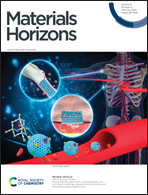Integrating molecular rigidity and chirality into thermally activated delayed fluorescence emitters for highly efficient sky-blue and orange circularly polarized electroluminescence†
Abstract
By integrating high molecular rigidity and stable chirality, two pairs of D*–A type circularly polarized thermally activated delayed fluorescence (CP-TADF) emitters with an almost absolute quasi-equatorial conformer geometry and excellent photoluminescence quantum efficiencies (PLQYs) are developed, achieving state-of-the-art electroluminescence performance among blue and orange circularly polarized organic light-emitting diodes (CP-OLEDs).

- This article is part of the themed collections: Materials Horizons 10th anniversary regional spotlight collection: China, Materials Horizons Lunar New Year collection 2022 and 2021 Materials Horizons most popular articles


 Please wait while we load your content...
Please wait while we load your content...